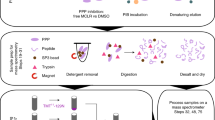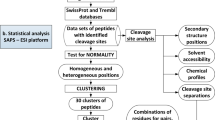Abstract
We describe an assay system for the identification of site-specific proteases. The assay is based on a protein substrate that is immobilized on ceramic beads. After incubation with cell homogenates, the beads are washed and digested with endoproteinase Lys-C to liberate a defined set of peptides. The peptide fragments are identified by mass spectrometry. The assay was used to screen for β-secretase, the protease that cleaves amyloid precursor protein (APP) at the β-site. Cathepsin D was identified as the enzyme responsible for β-secretase-like activity in two cell lines. Subsequent analysis of the related aspartic protease, cathepsin E, revealed almost identical cleavage specificity. Both enzymes are efficient in cleaving Swedish mutant APP at the β-site but show almost no reactivity with wild-type APP. Treatment of cell lines with pepstatin inhibited the production of amyloid peptide (Aβ) when they were transfected with a construct bearing the Swedish APP mutant. However, when the cells were transfected with wild-type APP, the generation of Aβ was increased. This suggests that more than one enzyme is capable of generating Aβ in vivo and that an aspartic protease is involved in the processing of Swedish mutant APP.
This is a preview of subscription content, access via your institution
Access options
Subscribe to this journal
Receive 12 print issues and online access
$209.00 per year
only $17.42 per issue
Buy this article
- Purchase on Springer Link
- Instant access to full article PDF
Prices may be subject to local taxes which are calculated during checkout





Similar content being viewed by others
References
Brown, A.M. et al. Biotinylated and cysteine-modified peptides as useful reagents for studying the inhibition of cathepsin G. Anal. Biochem. 217, 139–147 (1994).
Matayoshi, E.D., Wang, G.T., Krafft, G.A. & Erickson, J. Novel fluorogenic substrates for assaying retroviral proteases by resonance energy transfer . Science 247, 954–958 (1990).
Younkin, S.G. The role of A beta 42 in Alzheimer's disease. J. Physiol. Paris 92, 289–292 ( 1998).
Selkoe, D.J. The cell biology of beta-amyloid precursor protein and presenilin in Alzheimer's disease. Trends Cell Biol. 8, 447– 453 (1998).
Thompson, A., Grueninger- Leitch, F., Huber, G. & Malherbe, P. Expression and characterization of human beta-secretase candidates metalloendopeptidase MP78 and cathepsin D in beta APP-overexpressing cells. Brain Res. Mol. Brain Res. 48, 206–214 ( 1997).
Huber, G. et al. cDNA cloning and molecular characterization of human brain metalloprotease MP100: a beta-secretase candidate? J. Neurochem. 72 , 1215–1223 (1999).
Chang, T. & Abraham, C.R. A novel brain cysteine protease forms an SDS stable complex with the beta-amyloid precursor protein. Ann. N.Y. Acad. Sci. 777, 189–196 (1996).
Abraham, C.R. et al. Purification and cloning of brain proteases capable of degrading the beta-amyloid precursor protein. Ann. N.Y. Acad. Sci. 674, 174–179 (1992).
Citron, M. et al. Inhibition of amyloid beta-protein production in neural cells by the serine protease inhibitor AEBSF. Neuron 17, 171 –179 (1996).
Citron, M., Teplow, D.B. & Selkoe, D.J. Generation of amyloid beta protein from its precursor is sequence specific. Neuron 14, 661– 670 (1995).
Perez, R.G., Squazzo, S.L. & Koo, E.H. Enhanced release of amyloid beta-protein from codon 670/671 “Swedish” mutant beta-amyloid precursor protein occurs in both secretory and endocytic pathways. J. Biol. Chem. 271, 9100–9107 (1996).
Hochuli, E., Döbeli, H. & Schacher, A. New metal chelate adsorbent selective for proteins and peptides containing neighbouring histidine residues. J. Chromatogr. 411, 177–184 ( 1987).
Fountoulakis, M. & Langen, H. Identification of proteins by matrix-assisted laser desorption ionization-mass spectrometry following in-gel digestion in low-salt, nonvolatile buffer and simplified peptide recovery. Anal. Biochem. 250, 153 –156 (1997).
Amano, T., Nakanishi, H., Oka, M. & Yamamoto, K. Increased expression of cathepsins E and D in reactive microglial cells associated with spongiform degeneration in the brain stem of senescence-accelerated mouse. Exp. Neurol. 136, 171–182 (1995).
Saftig, P. et al. Amyloidogenic processing of human amyloid precursor protein in hippocampal neurons devoid of cathepsin D. J. Biol. Chem. 271, 27241–27244 (1996).
Sastradipura, D.F. et al. Identification of cellular compartments involved in processing of cathepsin E in primary cultures of rat microglia. J. Neurochem. 70, 2045–2056 ( 1998).
Finley, E.M. & Kornfeld, S. Subcellular localization and targeting of cathepsin E. J. Biol. Chem. 269, 31259 –31266 (1994).
Haas, C., Capell, A., Citron, M., Teplow, D.B. & Selkoe, D.J. The vacuolar H(+)-ATPase inhibitor bafilomycin A1 differentially affects proteolytic processing of mutant and wild-type beta-amyloid precursor protein. J. Biol. Chem. 270, 6186 –6192 (1995).
Döbeli, H. et al. Recombinant fusion proteins for the industrial production of disulfide bridge containing peptides: purification, oxidation without concatamer formation, and selective cleavage. Protein Expr. Purif. 12, 404–414 (1998).
Hill, J., Montgomery, D.S. & Kay, J. Human cathepsin E produced in E. coli. FEBS Lett. 326, 101–104 (1993).
Vassar, R. et al. β-sectretase cleavage of Alzheimer's amyloid precursor protein by transmembrane aspartic protease BACE. Science 286, 735 –741 (1999).
Hussain, I. et al. Identification of a novel aspartic protease (Asp2) as β-secretase . Mol. Cell. Neurosci. 14, 419– 427 (1999).
Wolfe, M.S. et al. Two transmembrane aspartates in presenilin-1 required presenilin endoproteolysis and β-sectretasse activity. Nature 398, 513–517 (1999).
Acknowledgements
We would like to thank Nicole Soder, Heidi Ortolf, Daniela Hügin, Veronique Horny, Daniel Mona, Peter Jakob, and Daniel Roeder for excellent technical assistance and Manfred Brockhaus, Hansruedi Loetscher, Georg Schmid, Jürgen Schläger, Beat Wipf, and Rommy von Bernhardi for their practical and scientific support. We are also very grateful to Prof. John Kay for generously providing purified cathepsin E and cathepsin E clone.
Author information
Authors and Affiliations
Corresponding author
Rights and permissions
About this article
Cite this article
Grüninger-Leitch, F., Berndt, P., Langen, H. et al. Identification of β-secretase-like activity using a mass spectrometry-based assay system. Nat Biotechnol 18, 66–70 (2000). https://doi.org/10.1038/71944
Issue Date:
DOI: https://doi.org/10.1038/71944
This article is cited by
-
Functional proteomics: application of mass spectrometry to the study of enzymology in complex mixtures
Analytical and Bioanalytical Chemistry (2012)
-
The cholinergic neuronal phenotype in alzheimer′s disease
Metabolic Brain Disease (2000)



